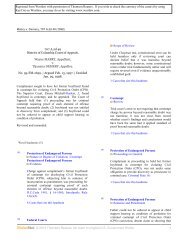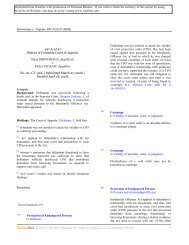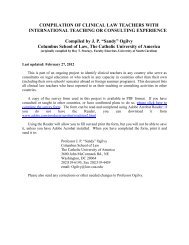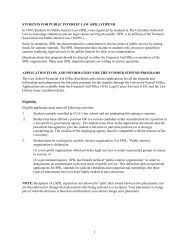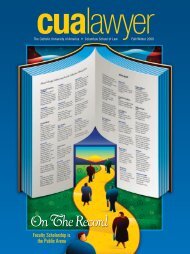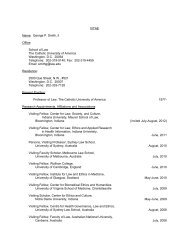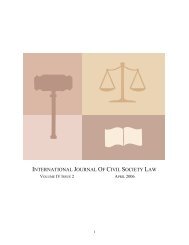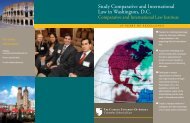SECURED VERSUS UNSECURED CREDITORS â BASIC TERMS
SECURED VERSUS UNSECURED CREDITORS â BASIC TERMS
SECURED VERSUS UNSECURED CREDITORS â BASIC TERMS
You also want an ePaper? Increase the reach of your titles
YUMPU automatically turns print PDFs into web optimized ePapers that Google loves.
<strong>SECURED</strong> <strong>VERSUS</strong> UN<strong>SECURED</strong> <strong>CREDITORS</strong> – <strong>BASIC</strong> <strong>TERMS</strong><br />
A. General Concepts and Terms:<br />
1. The status of being secured is a fundamental divide between creditors.<br />
2. A creditor with a lien on specific property of the borrower/debtor is a secured creditor.<br />
A lien exists only as to identifiable property (although certain liens, such as federal tax liens,<br />
may attach to all property of a debtor).<br />
3. A lien is a right of a creditor to repaid from the proceeds of the property subject to or<br />
encumbered by the lien.<br />
4. Property subject to the secured creditor’s lien is the secured creditor’s collateral.<br />
5. A voluntary lien in personal property is typically known as a security interest, which is<br />
the term used in Article 9 of the Uniform Commercial Code.<br />
6. A voluntary lien in real property is typically known as either a mortgage or deed of<br />
trust.<br />
7. A lien can encumber both tangible and intangible property (such as a copyright, or an<br />
account receivable) as well as after-acquired property.<br />
8. A lien creates leverage and reduces risk as to the secured creditor’s ability to obtain<br />
repayment. Because of the secured creditor’s lower risk, it should be able to extend credit at a<br />
lower interest rate and to a wider group of borrowers/debtors.<br />
9. A lender without a lien is an unsecured creditor or general creditor, and the lender’s<br />
claim is an unsecured claim.<br />
10. A secured creditor typically has the right to repossess and sell its collateral following the<br />
borrower’s default.<br />
11. A secured creditor whose collateral is worth more than the amount of the creditor’s claim<br />
is over-secured. A secured creditor whose collateral is worth less than the amount of the<br />
creditor’s claim is under-secured.<br />
12. As a practical matter, an under-secured creditor holds two types of claim against the<br />
borrower. The creditor is a secured creditor up to the value of its collateral, and an unsecured<br />
creditor for the remaining balance of its claim (the deficiency amount).<br />
13. An unsecured creditor holds no claim against specific property of a debtor. Upon its<br />
debtor’s default, it may not seize any the debtor’s property, but must instead sue for a judgment<br />
on its claim.
B. Types of Secured Claims and Liens:<br />
1. A voluntary lien or security interest is created by contract.<br />
2. The contract creating a security interest in personal property is a typically referred to as a<br />
security agreement. The security agreement identifies which property is subject to the security<br />
interest.<br />
3. There are three requirements for a security interest to be effective between the creditor<br />
and the debtor: (a) the debtor must have signed a security agreement; (b) the creditor must have<br />
provided value/credit to the debtor; and (c) the debtor must have rights in the collateral.<br />
4. When the foregoing three requirements are satisfied, the security interest has attached to<br />
the collateral.<br />
5. For a security interest to be effective against other creditors of the debtor, it must be<br />
perfected. A security interest is most often perfected by the filing of a filing statement with the<br />
appropriate state recording office. When the debtor is an enterprise organized under state law<br />
(i.e., a corporation or limited liability company or limited liability partnership), the filing<br />
statement is properly filed with the recording office of the state of the debtor’s organization,<br />
without regard to the location of the collateral.<br />
6. A judicial lien is an involuntary lien created as part of the process of collecting a<br />
judgment.<br />
7. A statutory lien is an involuntary lien created by statute or under the common law to<br />
protect a specific type or class of creditor. Examples of statutory liens are landlord liens for<br />
unpaid rent; tax liens for unpaid taxes; and mechanics’ liens for unpaid goods and services<br />
provided to real estate projects.<br />
8. A purchase money security interest (“PMSI”) is a security interest granted to secure the<br />
repayment of the loan used by the debtor to acquire the collateral. A non-PMSI is a security<br />
interest granted in property which the debtor already owns.<br />
8. A voluntary lien in collateral has priority over the debtor’s right under state law to<br />
declare the property as exempt. Involuntary liens in collateral are typically subordinate or junior<br />
to the debtor’s rights to declare the property in question as exempt.<br />
9. State law exemption is typically ineffective



